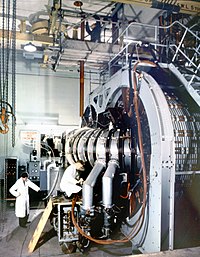
Photo from wikipedia
In some conditions, I-mode plasmas can feature pedestal relaxation events (PREs) that transiently enhance the energy reaching the divertor target plates. To shed light on their appearance, characteristics and energy… Click to show full abstract
In some conditions, I-mode plasmas can feature pedestal relaxation events (PREs) that transiently enhance the energy reaching the divertor target plates. To shed light on their appearance, characteristics and energy reaching the divertor targets, a comparative study between two tokamaks — Alcator C-Mod and ASDEX Upgrade — is carried out. It is found that PREs appear only in a subset of I-mode discharges, mainly when the plasma is close to the H-mode transition. Also, a growing oscillating precursor before the PRE onset is observed in the region close to the separatrix in both devices, and a discussion on a possible triggering mechanism is outlined. The PRE relative energy loss from the confined region is found to increase with decreasing pedestal top collisionality νped* . Similarly, also the relative electron temperature drop at the pedestal top, which is related to the conductive energy loss, rises with decreasing νped* . Based on these relations, the PRE relative energy loss in future devices such as DEMO and ARC is estimated. Finally, the divertor peak energy fluence due to the PRE is measured on each device. Those values are then compared to the model introduced in Eich et al (2017 Nucl. Mater. Energy 12 84–90) for type-I edge localized modes. The model is shown to provide an upper boundary for PRE energy fluence data, while a lower boundary is found by dividing the model by three. These two boundaries are used to make projections of the PRE divertor energy fluence to DEMO and ARC.
Journal Title: Nuclear Fusion
Year Published: 2021
Link to full text (if available)
Share on Social Media: Sign Up to like & get
recommendations!